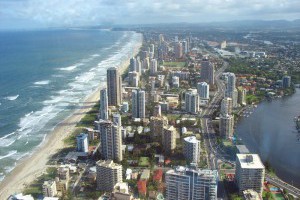Until the 1960s, the Gold Coast was just a string of sleepy coastal villages. The Gold Coast population explosion that has occurred since that time is one of the amazing stories in Australian demographics, as this place, which didn’t exist as a city before 1958 has grown to become Australia’s 6th largest urban centre, and largest non state capital.

What is the population of the Gold Coast?
The official population of the City of Gold Coast is currently (June 2011) estimated at 536,480 people by the Australian Bureau of Statistics. This is a preliminary estimate which may be revised after the Census data comes out, but is unlikely to be changed radically. You can always find the latest population of the Gold Coast on their online community profile.
This includes just the Gold Coast LGA. However the ABS regards the Gold Coast urban area as larger, because it includes the contiguous Tweed district in Northern NSW, which has 68,715 people, bringing the total for the Gold Coast-Tweed area to 600,475 people.
This makes the Gold Coast the 6th largest urban centre after Sydney, Melbourne, Brisbane, Adelaide and Perth, and the largest centre which is not a state capital. Gold Coast-Tweed Heads overtook Newcastle for this honour in 2007, and now has 50,000 more people.
The inclusion of Tweed in NSW also means that the Gold Coast has the distinction of being the only large population centre in Australia to be split over 2 time zones (for half the year, as Queensland doesn’t have daylight saving).
Though population growth has slowed in the recent economic downturn, over 10 years, the Gold Coast’s growth has been spectacular. In 2001, the population was 438,136, so it has had a 37% increase in 10 years, which is enormous for such a large centre.
Where is growth occurring?
The Gold Coast is a single LGA, plus the Tweed area in NSW, so it can’t be analysed by LGA. Fortunately the ABS produces growth figures based on roughly suburb-sized SLAs.
Contrary to most Australian’s visualisation of the Gold Coast, the largest growth hasn’t been occurring on the coast at all, but in the inland areas around the Pacific Highway, places like Pacific Pines, Upper Coomera and Ormeau, which are within commuting distance of Brisbane (and now virtually join up with the Brisbane urban area at Pimpama). Also masterplanned communities in Robina and Varsity Lakes feature prominently.
Source: Australian Bureau of Statistics, Regional Population Growth, Australia, 2010-11 (3218.0)
Tourist areas that most Australian’s know well such as Surfers Paradise, Broadbeach and Burleigh Heads are well down the list. In fact only two coastal areas make it into the top 10 growth areas of the Gold Coast, being Hope Island, a new canal development at the northern tip of the Gold Coast, and the Tweed Coast region at the far southern tip, south of Tweed Heads. This is most likely because these are the only places left with greenfield land left in coastal districts. Though there have been many new apartment towers built in the main tourist strips in recent years, because they mainly hold temporary occupants, you need to build a lot of them to have much effect on the resident population.
What will Gold Coast’s population look like in the future?
So what of the future? .id don’t currently have forecasts for the Gold Coast, though we do for the Tweed Council area in NSW. However the Queensland Office of Economic and Statistical Research do population projections (based on trendlines). They produce a high, medium and low series, which makes it a little difficult to analyse, however picking the medium series shows that the Gold Coast is expected to grow by another 47% by 2031, reaching a population of just under 800,000 in the next 20 years. And this relates only to the Queensland part of Gold Coast. Adding in .id’s forecasts for the Tweed Heads and coast districts shows another 101,000 people in this area so that the total population of the urban area should reach about 900,000 at that time.
2011 Census data will be released on 21 June 2012. Do check out this space or join us on twitter @dotid if you would like to receive more updates about the Census or information about demographic and economic trends. You may also like to visit us at id.com.au where you can access our demographic resource centre.












